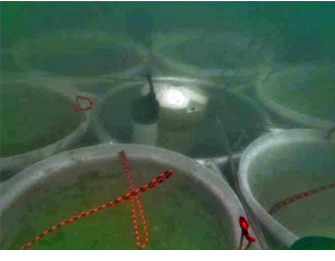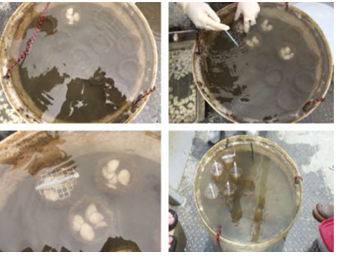
|
REMEDY AND RECONTAMINATION ASSESSMENT ARRAYThe Remedy and Recontamination Assessment (RARA) array system was developed by U.S. Navy researchers as a tool to assess different potential remedies in situ, and on-site, prior to full or pilot-scale implementation. Developed under SERDP Project ER-2537, remedies that can be evaluated using the array include Amendments (e.g., activated carbon), Monitored Natural Recovery, Enhanced Monitored Natural Recovery, capping, and other treatments that can be accommodated within the vertical scale of the array. |
|
The RARA array is a set of bundled microcosms (sediment cells) that can loaded with the contaminated site sediment and the targeted remedy, and then deployed onto the sea floor. For the ER-2537 project, the array included six, 17 gallon flat bottom cylindrical tanks for the microcosms, and bundled onto the frame sediment traps, an acoustic doppler current profiler (ADCP), an optical backscatter sensor (OBS), and oxygen and temperature probes. The ADCP data were used to evaluate both hydrodynamics and particle plumes, while the OBS provided direct measurement of particle concentrations in the water column near the array. The temperature and dissolved oxygen sensors provided data important for assessing conditions for caged organisms that were deployed within the arrays. The RARA design was intended to balance the requirements for multiple treatments, controls and replication with the constraints of size, weight, deployability and cost. |
|
|
The estimated cost for the unit in the ER-2537 report was $4,500. Detailed specifications for constructing and outfitting an array are included in the report.
|
|
|
|
|
|
An example of how the RARA can be used for in situ remedy testing is shown in the figures to the right. Testing a design for Enhanced Monitored Natural Recovery using thin-layer sand treatments, the sediment cell is first loaded with site sediment prior to sand application with clam chambers installed (A), application of silica sand visual tracer at sediment/EMNR interface (B), addition of thin sand layer (C), and final result with treatment and overlying water added (D). The sediment cells were lowered to the seafloor to the secured RARA frame, clams and passive samplers added to the chambers, and the array was left in place for 28 days.
|
|

|
|
Additional Resources |






